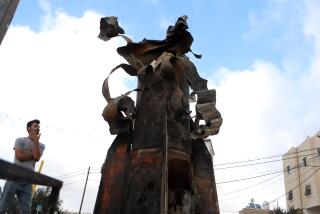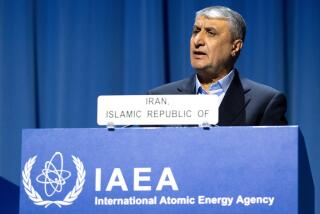Iran, weapons, secrets and threats
Representatives of six major world powers and Iran will begin talks on the Islamic Republic’s nuclear program when they meet Thursday. Here is a primer on the issues to be discussed.
Who will participate in the talks in Geneva?
The discussions will be under the auspices of the United Nations, whose International Atomic Energy Agency is the world’s watchdog on nuclear weapons. Iran will face the so-called P5 plus one: the five permanent members of the United Nations Security Council -- the United States, Britain, France, Russia and China -- plus Germany.
What are the general goals?
Long term, the United States and its allies want Iran to give up any aspirations of becoming a nuclear power. Short term, they want the IAEA to be allowed to inspect nuclear sites, including the latest to be reported near the holy city of Qom, about 100 miles from Tehran, the capital.
Iran says it is willing to allow the Qom plant to be examined and will talk to the IAEA about a timetable. But Iran says its nuclear program is only for peaceful purposes. It also wants to forestall harsher economic sanctions, which the United States has threatened to seek.
Why is the Qom plant important?
President Obama, British Prime Minister Gordon Brown and French President Nicolas Sarkozy were critical of Iran for secretly building a facility that they said was the right configuration to make weapons-grade enriched uranium. Iran, which notified the IAEA after learning that the West knew of the facility, maintains that it is not required to announce anything until six months before the facility is ready for use. It denies that the plant will be used to produce weapons-grade uranium.
What is weapons-grade uranium?
Uranium is mined and needs to be concentrated, or enriched, to have any value as a fuel for reactors to generate electricity or for a weapon. Gas centrifuges are used to concentrate the ore, which contains two isotopes of uranium.
Low enrichment means that the product that comes out of the centrifuges contains less than 5% of the more potent isotope, U-235, and can be used for fuel. Weapons-grade or highly enriched uranium contains 90% of the fissionable U-235 isotope.
What do we know about the Qom facility?
Western intelligence has been monitoring the construction of the underground facility for years, according to the Obama administration. It is designed to hold about 3,000 gas centrifuges. The West argues that the 3,000 centrifuges are too few to produce a significant amount of fuel for generating electricity but could produce enough highly concentrated uranium to make one or two bombs a year.
Iranian Vice President Ali Akbar Salehi, head of the country’s Atomic Energy Organization, has said the Qom plant was built within a mountain and next to a military base for protection from attack. The plant has been named Meshkat, which means Lantern.
Is Qom the only enrichment facility?
No. There is another facility at Natanz. It was revealed by Iranian exiles and dissidents, which led Iran to acknowledge its existence to the IAEA in 2002. Natanz, about 100 miles southeast of Qom, is open to IAEA inspectors, who say it has about 8,000 gas centrifuges producing about 4 pounds of low-enriched uranium fuel a day. Iran has a stockpile of more than 3,000 pounds of such fuel, which can be used in reactors to make electricity.
FOR THE RECORD: An earlier version of this article incorrectly stated that Natanz was about 20 miles north of Qom.
What is the status of Iran’s nuclear program?
In addition to enriching uranium, a nuclear weapons program includes developing a warhead and building a missile to deliver the weapon. According to Western intelligence agencies, Iran is one to five years away from developing nuclear capability, though it is unclear whether the Islamic Republic has even decided to build a weapon. U.S. intelligence believes that Iran is working on a ballistic missile that could carry a nuclear warhead but that those efforts have slowed. Partly because of that, the United States recently backed out of an agreement for a missile shield in Eastern Europe.
What about the missile tests?
Iran has successfully tested two medium-range missiles, the Shahab-3 and the Sejil. Both can carry warheads and have a range that reaches 1,200 miles, putting Israel and parts of Europe within striking distance.
Are there nuclear warheads?
The United States has said that Iran halted warhead design in 2003, a conclusion based on intelligence reports using information gleaned from Iran’s computer system. Israel, however, says it believes that Iran restarted weapons work in 2005.
Are there other worries?
There are four sites in Iran that are causing concern, according to Western intelligence: the two uranium-enrichment facilities and two reactors, which can be used to produce weapons-grade plutonium.
What and where are the reactors?
A heavy-water plant is being built in Arak but is not expected to have a reactor vessel until 2011. A light-water reactor is being built by the Russians in Bushehr. It is expected to be fueled this year but could take years to begin producing plutonium.
If the Russians are helping to build a reactor, do they support Iran?
It is unclear whether the Russians will stand by Iran or back the U.S. call for tougher sanctions if Iran continues its nuclear program. The information about the facility near Qom apparently caught Russia off guard when Obama explained the situation at a private meeting with President Dmitry Medvedev at the United Nations. Medvedev said afterward that he would support some sanctions.
Obama also briefed Chinese President Hu Jintao, but it is unclear whether the Chinese would support a proposal for more sanctions.
Isn’t Iran already under sanctions for its nuclear program?
Yes. The United Nations approved three rounds of sanctions in December 2006, March 2007 and March 2008. Iran is barred from importing and exporting nuclear material. It is also banned from exporting arms, and some assets have been frozen. .
What are the plans for new sanctions?
The latest sanctions call on nations to avoid doing business with Iranian banks if they are believed to be financing a nuclear weapons program. They also seek cargo inspections if warranted. Obama has called for tougher sanctions, believed to be aimed at Iran’s energy and transportation sectors as well as its banks. Also being considered is a ban on gasoline imports by Iran, though it is unclear whether that will gain support at the U.N., where sanctions require the approval of Security Council members, including Russia and China.
Twitter latimesmuskal
More to Read
Sign up for Essential California
The most important California stories and recommendations in your inbox every morning.
You may occasionally receive promotional content from the Los Angeles Times.











